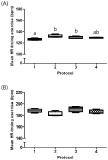Purpose The purpose of this study was to find out whether they can contribute to the revitalization of urban communities. Methods This study conducted in-depth interviews and focus group interviews to collect qualitative data. The collected data were analyzed through the domain analysis and the classification analysis. Results The roles of sports club managers in leadership and network intermediaries were very important in the accumulation of social capital. The formation of staff members who work for the managing and activating sports clubs has created trust and satisfaction with the sport. Their activities contributed to the formation of social capital in sports clubs and played an important role in revitalizing sports clubs. Conclusions Sports club managers performed important roles in building trust and network with the club members and even other clubs through their leadership. These management activities are possibly contributed to the creation and accumulation as social capital. Therefore this research also showed the possibilities of extension to local community of the social capital through sports clubs.
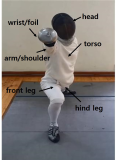
Purpose The purpose of this study was to establish the differences of anticipating accuracy and confidence according to fencing expertise and spatial occlusion region. Methods For the purpose of this study, the anticipation ability of 6 high-level fencing players and 6 low-level fencing players were analyzed. All subjects performed the 60 tasks of anticipating the attack positions(thorax, thigh, toe) from observing the fencing video screen using spatial occlusion technique. The spatial occlusion technique was used in 6 particular body of opponent’s movement. For statistic analysis, data was analyzed through independent T-test measure. Moreover, Paired t-test were used as follow-up analysis. Results The results of the study were as follows: In terms of accuracy anticipation, the main effect of expertise was significantly different. Specifically, when the spatial occlusion technique was applied in head, left leg, arm, and a foil, the accuracy of anticipation was significantly different. Moreover, comparing with no-occlusion condition, anticipation accuracy decreased when spatial occlusion technique was applied in arm and foil. In terms of confidence, there was no significant difference between level of expertise. Conclusions In order to effectively anticipate the opponent’s movement in fencing sports, it is necessary to focus on the visual cues of arm/shoulder, and the foil. Especially, focusing on the foil movement might provide the core informations on anticipation ability.

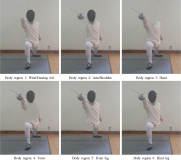
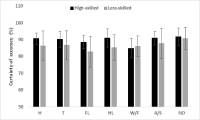

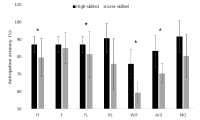
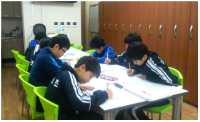
The purpose of this study was to verify the effect on elementary school students in the exercise start stage by performing a sport psychological skill training to improvement of psychological skill and life skill. Participants were eight elementary school boys volleyball player. The program consisted of psychological skills and life skills in educational counseling model of Visek et al(2009). It was conducted 40-50 minutes a session in total for 22 sessions. Data was collected through a psychological test, worksheet and participant observation, in-depth interviews. The collected data was analyzed to verify difference by paird t-test after pre-middle-post test and to extract meaningful data category. Quantity analysis showed that a result of sport psychological skill test proved a significant difference in willingness to overcome, confidence, concentration, anxiety regulation. Life skill test were no significant differences in all factors. However, the rise of scores was observed on result of the pre-middle paired t-test of life skill during season. Quality analysis showed possibility of goal setting, concentration on the routine, decrease of competitive anxiety, increase of positive thinking, self-understanding and understanding of others, promotion of communication among team members. This sport psychology skill training had a significant effect on the psychological skills of elementary players change. But it seems to be necessary life skills in a more through review of the information.


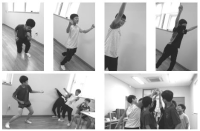
PURPOSE This study aimed to apply a team-building program for preparing the national archery team for competition in the Olympics. METHODS To achieve the purpose of this study, six national archers (three men and three women) were included. The team-building program was applied for a total 6 sessions (one session per week). Group cohesion and efficacy were measured three times before, after, and at a later application of the program. The collected data were analyzed with the Friedman and Wilcoxon signed-rank tests, which are nonparametric statistical techniques for data analysis. In addition, an in-depth interview for qualitative data was conducted for each archer to explore the effects and changes resulting from participation in the program. RESULTS The results of the study are as follows: first, the levels of team cohesion and efficacy in the national archery team increased after the implementation of the program compared to those in the pre-implementation state. Furthermore, high levels of team cohesion and efficacy were maintained at the follow-up measurement. Second, the archers recognized that closeness and faith in one another increased more between team members. Furthermore, there were positive changes in team communication, atmosphere, cohesion, and efficacy during team matches. CONCLUSIONS The team-building program applied in this study was found to have a positive effect on various factors related to team cohesion, such as team communication and team atmosphere. Therefore, future studies should consider developing a team-building program that can contribute to improving team sport performance for different sports and the effects of the program should be examined using various methods.
The purpose of this study was to conduct an in-depth exploration of Korean national badminton players’ psychological momentum strategies. Data were collected using an open-ended questionnaire and group interviews of 66 badminton players, including 40 members of the 2018 Korean national badminton team and 22 college and semi-pro badminton players who each had badminton careers of 10 or more years and were registered in the Badminton Korea Association. The data were analyzed using inductive content analysis and the deductive process based on the inductively categorized results. The results are as follows. First, regarding strategies for maintaining positive momentum, 188 raw data were collected and classified into three category (keeping pace, dominating the play, and psychological facilitation) and 10 sub-category (including speedy resumption of the game, attacking weak points, and fighting shout). The results suggest that badminton players maintain positive momentum by using strategies to control the speed and tempo of the game at their preferred pace, implement special techniques, exploit their opponent’s weaknesses, and cheer or talk amongst themselves to motivate each other and communicate with their partners and coaches. Second, regarding strategies for overcoming negative momentum, 293 raw data points were collected and classified into three category (time outs, psychological reminders, and changes in plays) and 11 sub-category (including delaying the game, seeking social support, and play change). The data demonstrate that badminton players overcome negative momentum using strategies to intentionally delay the game and exchange equipment, focus on performance cues, and interact with their coaches and partners to change plays and prevent errors. It is hoped that these study findings will inform efforts to provide psychological support that is effective in increasing the odds of winning for the national badminton players in the Asian Games and the Olympic.
The purpose of this study was to investigate the level of factors associated with points and the difference among weight categories after the revision of wrestling competition rules from video images. Factors associated with points were average point per a game, average points according to playing type, the occurring frequency of point according to the skills, the frequency and successful ratio of Parter, and the time zone of points occurred. The video contents were concerned on athletes ranked in 1 - 5 (6 person) at 59, 66, 75 Kg categories of Greco-Roman style in the 2014, 2015 World Wrestling Championship. The analysis was done by watching TV monitor several times. Five quantitative factors were tested between weight categories. As the results, no significant difference was found in average obtained point, but significant difference was found in average lost point (p<.05). Average obtained point showed significant difference in cross effect of the type of game and weight category. And average lost point showed significant difference in the type of game (p<.01) and weight category (p<.05), too. The frequency of point by skills of stand and ground wrestling showed significant difference in weight category (p<.001). However, no significant difference was found in frequency of point by time zone among weight categories. In conclusion, the point obtained and lost and the frequency of it are associated with the type of game and skills included in it of Greco-Roman style wrestling. New training program focused on enforcing the correct type of game and skills in it might be useful for developing the performance.
PURPOSE This study compares the effects of video group and metaverse group counseling for student athletes to analyze differences in immersion, sychological skills learning effects, and each approach’s participation experiences. METHODS Twenty-four high school archery students were divided into three groups: a metaverse experimental, a video comparison, and a control group. For the experimental and comparative groups, 10 non-face-to-face psychological skills training sessions were conducted. With the control group, results were compared and analyzed by measuring psychological skills and social presence pre- and post-training. Additionally, analysis of the qualitative effects of psychological skills training was performed. RESULTS The psychological skill test’s quantitative analysis of the video comparison group showed a more significant effect in anxiety control factors than the metaverse experimental and the control groups. Moreover, in the social presence test, both the metaverse and the video groups showed significant differences in social presence and satisfaction; furthermore, Scheff post-verification results showed that the two environments’ satisfaction was significantly higher than that of the control group. Qualitative analysis confirmed that the metaverse and video groups experienced psychological, technical, and relational changes in common. CONCLUSIONS Although the metaverse group using avatars was likely to increase immersion, both the video and the metaverse groups were effective in psychological skills training, suggesting that the training effect may vary depending on the non- face-to-face environment’s stability and participation method. Future studies should examine effects of applying the metaverse platform to sports psychological skills training and various psychological support activities by solving the metaverse environment’s technical limitations.
PURPOSE The purpose of this study was to analyze the level and characteristics of physical activity (sedentary, light, and MVPA) of high school students according to physical education (PE) class (DWPE: days with PE class, DNPE: days with no PE class) and sex. METHODS Data were collected on 147 students (65 male and 82 female) from four high schools in Seoul city, and physical activity was measured using a three-dimensional accelerometer. The collected physical activity data were input into SPSS 25.0, and the descriptive analysis and two-way ANOVA according to PE class and sex were performed. RESULTS The descriptive statistical analysis showed that 31% (40.7% male and 23.4% female) of participants met the recommended physical activity durations (MVPA of 60 min/day). In the two-way ANOVA, sedentary activity, light activity, and MVPA showed statistically significant main and interaction effects according to PE class and sex. According to the results of the interaction effect analysis, the gap in physical activity between DWPE and DNPE was large in male students. For male students, light activity and MVPA significantly increased on the day of the PE class, and sedentary activity significantly decreased. However, for female students, DWPE and DNPE did not differ significantly in all levels of physical activity. CONCLUSIONS In conclusion, the level of physical activity of Korean high school students was relatively low, and the effect of daily-life physical activity in the PE class was limited to male students. Accordingly, an alternative should be introduced to increase the physical activity of female high-school students through PE classes.
PURPOSE This study aimed to analyze physical activity (sedentary, light, moderate to vigorous physical activity [MVPA]) characteristics of middle school students based on region (urban and rural) and sex. METHODS Data were collected from 216 students across 6 middle schools located in medium-sized urban (3 schools) and rural areas (3 schools), and the relevant physical activity was measured using a three-dimensional accelerometer (GT3X model). The collected data were inputted into the SPSS 20.0, and descriptive analysis and two-way ANOVA based on region and gender were performed (<.05). RESULTS The descriptive statistical analysis resulted in the following achievement rate of the physical activity standard (MVPA 60 minutes/day): 9.4%. The two-way ANOVA showed that the main effect according to gender was found in sedentary activity (F=5.258), light activity (F=6.790), and MVPA (F=32.274); furthermore, the main effect according to region was found in light activity (F=10.888) and MVPA (F=7.876). Interaction effect according to region and gender was found at all intensities, and the gap between rural and urban in male students was larger compared to that of female students. CONCLUSIONS After COVID-19, the level of physical activity among adolescents has worsened; this study found the problem of "decrease in physical activity; increase in sedentary activity" to be more serious among male students in urban areas.

Purpose The purpose of this study was to investigate changes of the cardiovascular system by comparing heart rate (HR) and blood responses to exercise in younger and older adult dogs and to verify the value of dogs as aging model in exercise science research. Methods A total of 11 healthy beagles were divided into 2 groups according to age: younger adult dogs (1~2 years old, 7 animals) and older adult dogs (9~11 years old, 4 animals). Each animal exercised on the treadmill for 25 minutes, twice a week, and for 4 weeks. The exercise intensity was gradually increased by applying four different protocols. Resting HR, HR during exercise, and HR recovery time were determined as HR parameters. Biochemical analysis was performed on blood samples. The independent Student’s t-test and one-way ANOVA were used to analyze the mean difference of each variable. The associations between age and HR parameters were determined using Spearman‘s analysis. Results Older adult dogs showed higher HRs during rest and exercise than younger adult dogs. HR recovery time was significantly longer in older adult dogs than in younger adult dogs. A strong positive relationship was observed between beagles’ age and resting HR, HR during exercise, and HR recovery time, respectively. The heart rate response to the treadmill exercise was similar between the 1st week and 4th week in younger and older adult dogs. Exercise significantly reduced the white blood cell level in older adult dogs and increased the alkali phosphatase level in younger adult dogs. Conclusions The results of this study demonstrated that short-term treadmill exercise may have a positive effect on the aerobic capacity, inflammation, and bone formation, suggesting that dogs are valuable as aging model in exercise science research.

